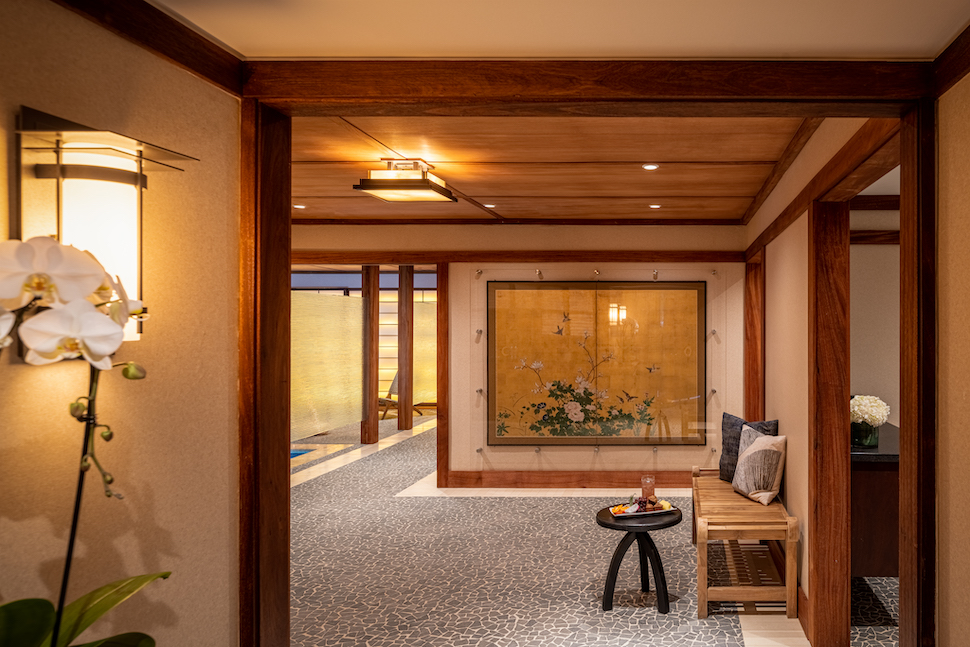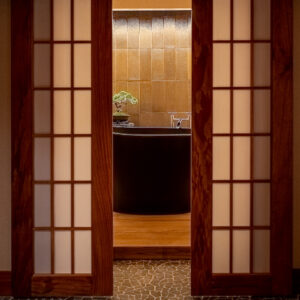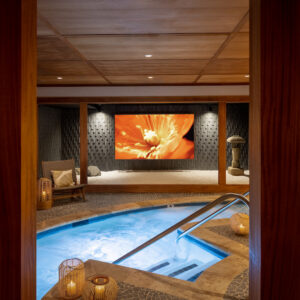
Last February, I received a teaser of a text from Kathy Van Ness, the Chief Operating Officer and General Manager of the iconic Golden Door. She had texted me a video of the unveiling of the enticing new bathhouse. The 64-year-old Golden Door had been on my mind because it’s 101-year-old founder, the equally iconic Deborah Szekely, had recently regaled me with stories of the Hollywood starlets she had invited to put the place on the map. Remarkably, the Golden Door is even chicer nowadays—and perhaps more relevant than ever.
Three months after receiving Van Ness’s text, I returned to the Golden Door for my third visit, eager to experience the new bathhouse. My first visit was in 2008, when I attended the Golden Door’s 50th birthday celebration; the second stay was in 2014, when under the new and current ownership, a series of upgrades were done to the guest rooms and lobby. The goal with that refresh was to simply restore the Door’s luster–and it did–thanks to the discerning eye of Van Ness and New York-based interior designer, Victoria Hagan.
 Originally opened in 1958, the property takes its aesthetic from the Japanese honjin, or inn. Bamboo forests, koi ponds, and Japanese gardens abound–as does an incredible (and very valuable) Asian art collection that Szekely amassed over the years. Before opening the Golden Door, Szekely and her architect embarked on a pilgrimage to educate themselves about the Japanese bathing culture—visiting 21 inns in 25 days. As a result, Szekely introduced Zen architecture as the visual vocabulary for Western spa and wellness destinations. Today’s mindfulness imagery–from three perfectly balanced stones to a branch of bamboo–owes a debt to Szekely’s travels and vision.
Originally opened in 1958, the property takes its aesthetic from the Japanese honjin, or inn. Bamboo forests, koi ponds, and Japanese gardens abound–as does an incredible (and very valuable) Asian art collection that Szekely amassed over the years. Before opening the Golden Door, Szekely and her architect embarked on a pilgrimage to educate themselves about the Japanese bathing culture—visiting 21 inns in 25 days. As a result, Szekely introduced Zen architecture as the visual vocabulary for Western spa and wellness destinations. Today’s mindfulness imagery–from three perfectly balanced stones to a branch of bamboo–owes a debt to Szekely’s travels and vision.
The biggest challenge in renovating the 2,550-square-foot bathhouse, according to Van Ness, was to keep its authenticity in this age of technology. To achieve that, Van Ness brought on San Diego-based designer Kristine Smith to oversee the $5 million project that included much-needed bright new sauna and steam rooms. Smith succeeded in modernizing the bathhouse while still remaining true to its Japanese aesthetic.
Designer Kristine Smith succeeded in modernizing the bathhouse while still remaining true to its Japanese aesthetic.
Another challenge was how to create different experiences in the bathhouse with limited space, and to create quiet places where guests could enjoy not only time alone, but each other’s company. “That was the beginning of imagining a space where people could gather and pause, have the quiet energy of other guests, but also have a space to lower their energy,” said Van Ness.
What she did was quietly radical: bringing in the time-lapse nature filmmaker Louie Schwartzberg to create what Van Ness describes as “a moving healing visual wall.” The large digital screen is set amidst elegant black bamboo tiles, and there is a small Japanese rock garden that adds depth to the room. As Van Ness explains, “If you can combine warm bubbling water with slow-moving visual imagery, a Japanese raked garden, and a private space, you will absolutely change your pace.”
 This healing space is the heart of the bathhouse, enclosed by authentic Japanese screens, and it is where the Jacuzzi is situated. It is also where I spent my time each morning and each evening before retiring. Every day, I stared at Schwartzberg’s images, trying to decide how I felt about this new addition. The images are breathtakingly beautiful, but did I want to be digitally transported from simply soaking in the bathhouse at the Golden Door? I admittedly am a purist. I don’t really want the distraction. But I was most definitely in the minority on this one. A fifty-something fellow guest shared with me that she believed the Golden Door added the digital art because the younger guests are so accustomed to screens. And, sure enough, the demographic here has changed, skewing younger. Yes, there are those loyal grande dames who have chalked up 40-plus visits in their day, but over the past 10 years, the demographic has shifted to the professional woman between the ages of 35 to 55.
This healing space is the heart of the bathhouse, enclosed by authentic Japanese screens, and it is where the Jacuzzi is situated. It is also where I spent my time each morning and each evening before retiring. Every day, I stared at Schwartzberg’s images, trying to decide how I felt about this new addition. The images are breathtakingly beautiful, but did I want to be digitally transported from simply soaking in the bathhouse at the Golden Door? I admittedly am a purist. I don’t really want the distraction. But I was most definitely in the minority on this one. A fifty-something fellow guest shared with me that she believed the Golden Door added the digital art because the younger guests are so accustomed to screens. And, sure enough, the demographic here has changed, skewing younger. Yes, there are those loyal grande dames who have chalked up 40-plus visits in their day, but over the past 10 years, the demographic has shifted to the professional woman between the ages of 35 to 55.
But back to the bathhouse. In addition to the rebuilt steam, sauna, and healing space, the bathhouse features three wrap rooms where the classic and deservedly legendary herbal linen wraps (created at Rancho la Puerta in the 1940s) are given; a locker room and dressing area with two showers; a new experience room that houses a Lightstim LED therapy table (guests had been asking for therapies that address inflammation, noted Van Ness); a chic little room with shimmering walls of metallic gold tile where a black stone soaking tub resides for both ice-cold plunges and hot aromatic baths; and lastly, a wet room with a brand new state-of-the-art Vichy shower by Kohler. The addition of the classic Vichy shower was a delightful and nice surprise to this spa purist.
Mary Bemis
Mary Bemis is Founder & Editorial Director of InsidersGuidetoSpas.com. An advocate for all things spa, Mary forged a vocabulary for spa reportage that is widely used by those who cover the issues today. Recently honored as a Top 30 Influential Voice Transforming Wellness by Medika Life, Mary is an inaugural honoree of Folio’s Top Women in Media Award. Her spa media roots run deep—in 1997, she launched American Spa magazine, in 2007, she co-founded Organic Spa magazine, and in between serving on the ISPA and NYSPA Board of Directors, she was on the launch teams of Luxury SpaFinder and New Beauty magazines. Named a "Wonder Woman of Wellness" by American Spa magazine, Mary was honored by the International Spa Association with the distinguished ISPA Dedicated Contributor Award. She is a special advisor to the non-profit Global Wellness Day.
- Web |
- More Posts(82)